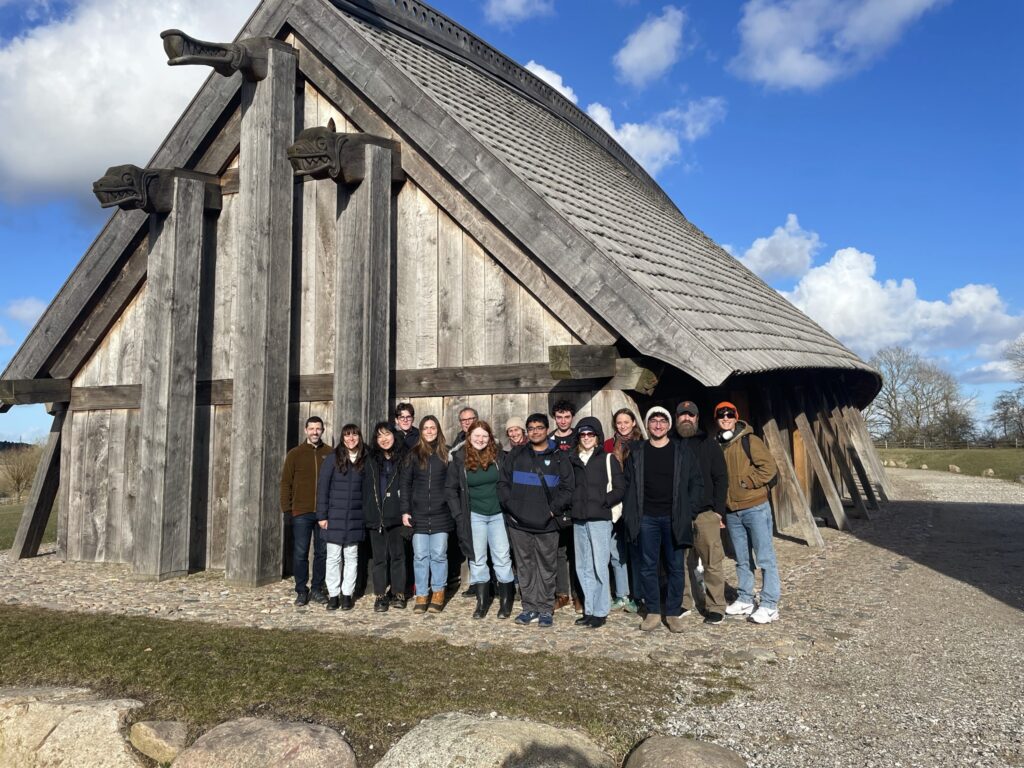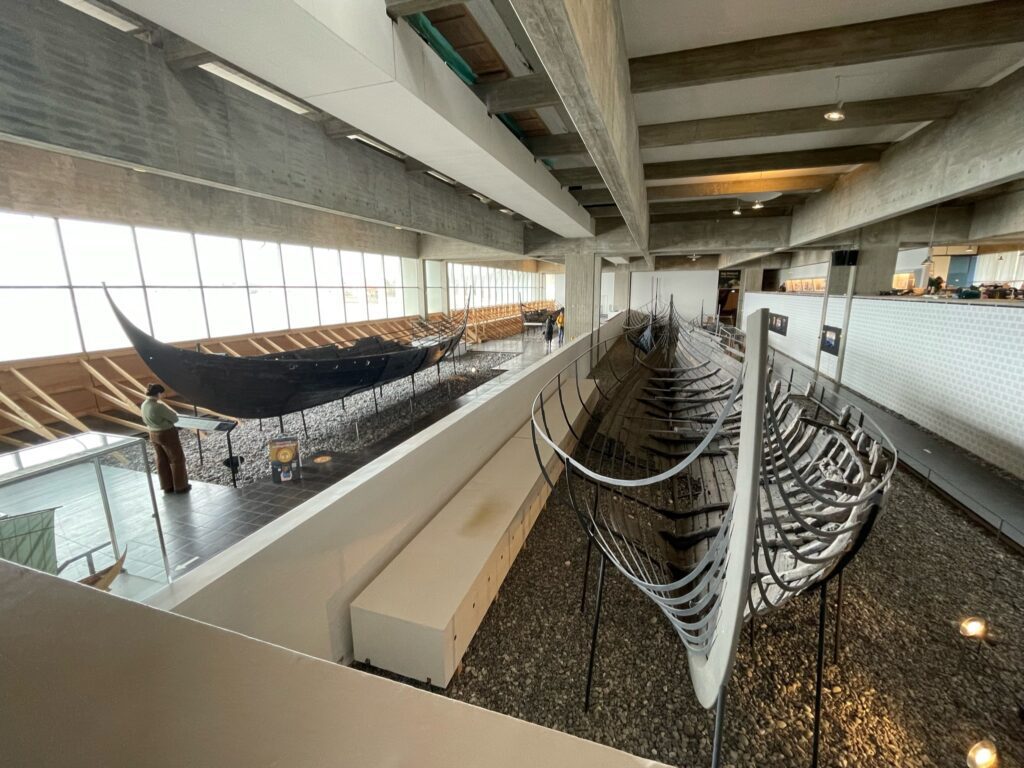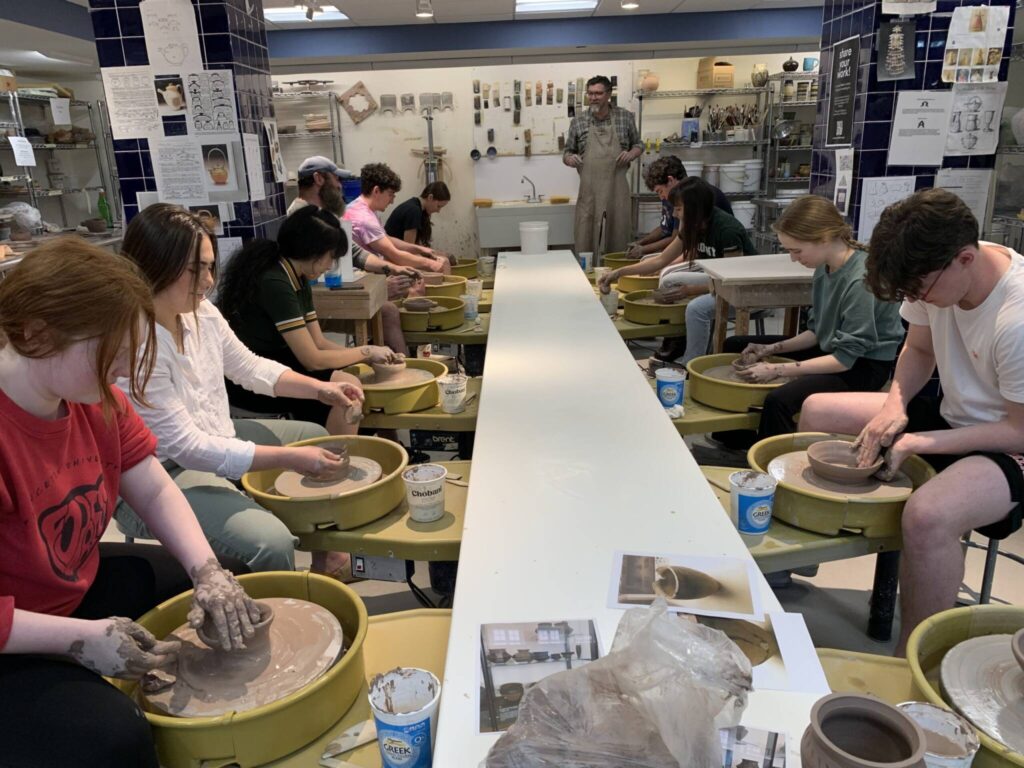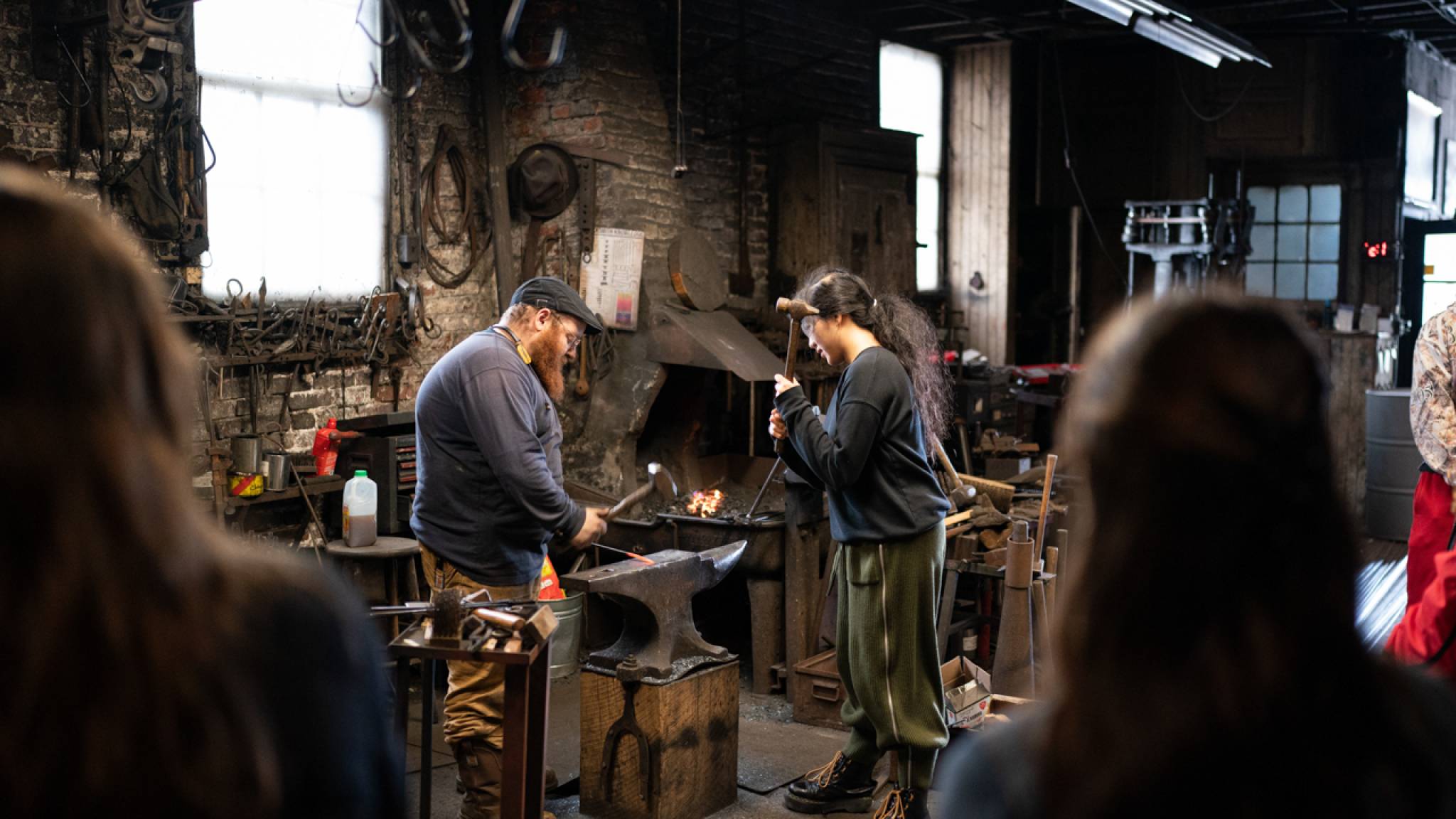“For this next part, everyone is going to need an axe.”
One at a time, 12 undergraduate students chose a blade from the toolbox in a studio at the Viking Ship Museum in Roskilde, Denmark, a city about 20 minutes west of Copenhagen by train. The task at hand was to make a snelle, a small but vital piece of a Viking vessel.
With help from Silas Tavs Ravn, a craftwork educator, each student measured, chopped and chiseled a jagged block of wood until it resembled the ancient binding.
The workshop, which took place during a spring break trip, was one of several immersive activities built into “Making the Viking Age,” a new seminar taught by Matthew Delvaux, lecturer in the Humanities Council, history and humanistic studies. Delvaux, a historian focused on the Middle Ages, is also the Haarlow-Cotsen Postdoctoral Fellow in the Society of Fellows.
The undergraduate class explored the complex lives of the people in Scandinavia and Northern Europe during the Viking Age — the approximate years between 700-1100 CE. Delvaux said he imagined the syllabus as a kind of “multidisciplinary experiment” that would build on his own expertise and tap into a popular topic of interest across a broad range of students from the humanities, social sciences and STEM fields. He worked closely with the Program in Humanistic Studies and the Humanities Council to develop the course with support from the David A. Gardner ’69 Magic Project, which encourages innovative teaching and research in the humanities.

Sunken ships, hidden stories
In the 11th century, Vikings who were seafaring pirates deliberately sunk five of their ships in Denmark’s Roskilde Fjord to block an important trade route and protect from enemy attacks at sea. These ships, called the Skudelev ships, were found and excavated by maritime archaeologists beginning in the late 1950s through the early 1960s and are now preserved in the halls of the Viking Ship Museum, which includes a working boatyard.
In Roskilde, the first stop on the break trip, the Princeton class stayed just steps from the fjord where the Skudelev ships were scuttled over a century ago. Meeting with curators, craftspeople, engineers and educators from the museum, the students learned about emerging Iron Age and Viking Age scholarship, and the museum’s efforts to both preserve and reconstruct cultural artifacts from the time period, including a host of Viking ships.
“[The course] wasn’t about Vikings as pure history, or Vikings as pure art, or pure literature,” said Daniel Viorica ’25, a comparative literature major who chose the class because of its cross-disciplinary approach — similar to the year-long, team-taught Western Humanities Sequence he’d taken his first year at Princeton. “The class taught us to engage not just with texts, but with things,” he said. “It was a totally different way of thinking about the world, a different method with which to approach the questions that we will be faced with in the future.”
After leaving Roskilde, the class traveled west to Lejre, a city that — according to Scandinavian sagas — played an important role in Denmark’s history, and the history of the Vikings. At the Lejre Museum, students explored archaeological finds, including “Odin of Lejre,” a small cast silver figurine of the Norse god that dates to around the year 900. They trekked through the cold March countryside to Lejre’s Land of Legends, a 106-acre open air history museum dedicated to research and reenactment of several time periods, including the Viking Age.
“Students went through the steps from dirt to display,” Delvaux said. “How do we recover archaeology, how do we display it, how do we reconstruct it, how do we study it?”
He hoped the wide variety of museums — which concluded with an excursion to the National Museum of Denmark in Copenhagen, home of the country’s largest collection of artifacts from the Viking Age, and its conservation branch in Brede — would allow students to think about the sometimes-competing narratives that were presented to them.
“I wanted students to understand that similar artifacts appearing across different museums have profoundly different meanings, based upon how they’re contextualized,” he said. “We can think through what different museums are doing and not just be passive recipients of the stories they are telling, but we can engage with them critically.”

Impromptu insight from Princeton faculty
Beatrice Kitzinger, associate professor of art and archaeology and Behrman Professor in the Humanities Council, and Charlie Barber, the Donald Drew Egbert Professor of Art and Archaeology, joined the class in Denmark. Their participation led to moments of impromptu learning throughout the week.
At the Roskilde Cathedral, Kitzinger offered a mini-lesson on medieval art and Biblical typology when the class encountered carved choir stalls from the 12th century. In Copenhagen, students joined Barber for an afternoon at the Glyptotek Museum, where they viewed a collection of Byzantine art. In Lejre, Kitzinger delivered the opening lines of the Old English epic “Beowulf” at the site of the excavated long hall thought to be at the center of the poem.
Kate Weseley-Jones ’25, an art & archaeology major, said that spending time with faculty abroad was a true bonus. “It’s one thing to engage with professors on campus and another thing to get to spend time with them for a whole week straight,” she said. “[But] how many times in your life do you get to go with a Byzantine art scholar to look at Byzantine art in Copenhagen?”
Spinning thread, forging metal: Experiencing Viking craftsmanship firsthand
Back in Princeton, students delved into more experiential learning with campus and community partners.
In Princeton University Library’s Special Collections, students examined minted coins and manuscripts from the Middle Ages. They tried their hand at metalworking during a workshop with the Blacksmith of Trenton. At the Arts Council of Princeton, they built pots from coils during a ceramics workshop, and returned a few weeks later for a textile class, where they dyed fabric and learned to spin thread on a drop spindle.
For the final assignment, students created an online exhibition – built with assistance from the McGraw Center for Teaching and Learning – to connect “material and textual evidence” from the period and reflect on how Viking Age stories and artifacts might resonate today. From writing short stories about women in Viking society, to an exploration of the role of animal interactions in culture, to a study of the impact of Viking trade with the Islamic world, the projects reflected a range of student interests.
Delvaux said he hopes students will take away a broad perspective on academic inquiry, beyond the particulars of the Viking Age. “I want students to leave with a better understanding of what it means to be human and to be better interrogators and inquirers and researchers of all facets in life.”

This story originally appeared on the University homepage. View the story and see more photos from the course.
















